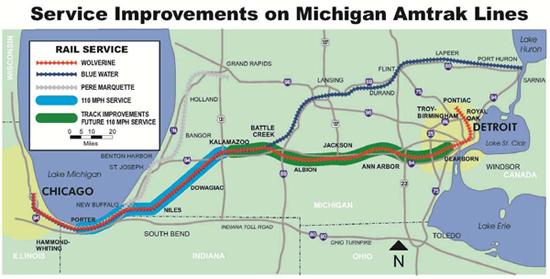Happening Now
Despite federal inaction, states continue to invest in Amtrak
October 7, 2013
Written By Colin Leach

As we’ve been reporting to you for the past few months, Amtrak’s state-sponsored services are enjoying all time highs in patronage and on-time performance. Americans are flocking to trains such as the St. Louis-Kansas City Missouri River Runner, the Chicago-St. Louis Lincoln Service and the New York-Pittsburgh Pennsylvanian due to their convenient schedules and reliable on-time performance.
What’s most remarkable about increased patronage is it comes at a time where continuing inaction at the federal level threatens the viability of Amtrak’s long-distance services. Whereas congressional opponents of Amtrak have offered amendment after amendment to cripple passenger service, if not defund the network entirely, state transportation departments are making necessary investments to improve their passenger rail service.
Michigan is a fine example. Recently, Michigan’s Department of Transportation (MDOT) announced that it, in conjunction with Amtrak, will invest millions of dollars in improving service on its Blue Water, Pere Marquette, and Wolverine services between Port Huron, Pontiac, Grand Rapids, and Chicago. These investments include improvements to both track and rolling stock. Concerning track improvements, the state and Amtrak to upgrade a section of state-owned track between Kalamazoo and Dearborn to allow for 110 mph operation. This track, acquired last fall by MDOT, will complement Amtrak’s already upgraded track between Kalamazoo and Porter, Indiana. Once these upgrades are complete, it is believed that trip time between Chicago and Detroit will be cut by two hours; the same time that an average car trip takes. By shortening trip times, MDOT expects vastly increased patronage.
But their investments aren’t limited to what’s “below the rail”. Amtrak and MDOT have also invested in adding bicycle racks to its Blue Water service to Port Huron. For a small $10 fee, passengers can now take their bicycles with them; a service that, when introduced on other routes, has proven quite popular. To further entice passengers, MDOT has invested more than $1 million to install wi-fi on all three lines by January 2014. MDOT and Amtrak believe that including free wi-fi makes the service an attractive alternative to both flying and driving, particularly for business customers. Both Amtrak and MDOT are hopeful that adding free wi-fi will attract enough new customers to offset the initial investment.
What can passenger rail advocates learn from Michigan’s experience? Michigan’s lead in investing in its own passenger service demonstrates that, more than ever, action on state and local levels is needed to secure the fast, frequent passenger train service that all American deserve.
Federal action is limited by both financial constraints and partisan divide. While NARP remains steadfast in its belief that substantial federal investment in passenger rail service is absolutely necessary, political realities are unfortunately limiting these possibilities. States, however, are in a unique position to make substantial investment in their own services at a time when the will to do so at a national level is limited. And investment in passenger rail is hardly a partisan affair. Michigan’s Republican Governor and Republican-controlled Legislature have taken the initiative to do more than just maintain existing services; they have worked together to increase investment and attract customers to the trains.
Not even congressional paralysis can stop passenger rail’s renaissance. Americans have proven that they want more and better passenger trains: just look at Amtrak’s record ridership figures. State governments are more eager than ever to take advantage of this rising demand and deliver a service that their citizens want.
Perhaps Washington should take a few cues from Lansing.
"Saving the Pennsylvanian (New York-Pittsburgh train) was a local effort but it was tremendously useful to have a national organization [NARP] to call upon for information and support. It was the combination of the local and national groups that made this happen."
Michael Alexander, NARP Council Member
April 6, 2013, at the Harrisburg PA membership meeting of NARP
Comments